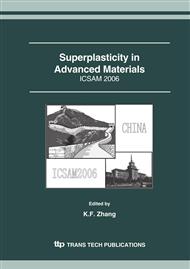p.597
p.601
p.607
p.615
p.621
p.627
p.633
p.639
p.645
Cavitation Behavior of Ultra-Fine Grained Ti-6Al-4V Alloy Produced by Equal-Channel Angular Pressing
Abstract:
Cavitation behavior during superplastic flow of ultra-fine grained (UFG) Ti-6Al-4V alloy was established with the variation of grain size and misorientation. After imposing an effective strainup to 8 via equal-channel angular pressing (ECAP) at 873 K, alpha-phase grains were markedly refined from 11 μm to ≈ 0.3 μm, and misorientation angle was increased. Uniaxial-tension tests were conducted for initial coarse grained (CG) and two UFG alloys (ε = 4 and 8) at temperature of 973 K and strain rate of 10-4 s-1. Quantitative measurements of cavitation evidenced that both the average size and the area fraction of cavities significantly decreased with decreasing grain size and/or increasing misorientation. It was also found that, when compared to CG alloy, cavitation as well as diffused necking was less prevalent in UFG alloys, which was presumably due to the higher value of strain-rate sensitivity. Based on the several theoretical models describing the cavity growth behavior, the cavity growth mechanism in UFG alloys was suggested.
Info:
Periodical:
Pages:
621-626
Citation:
Online since:
July 2007
Authors:
Price:
Сopyright:
© 2007 Trans Tech Publications Ltd. All Rights Reserved
Share:
Citation:


